A bridge is not only a way to get from one tower to another: it's an adventure and an experience all on its own.
Kids love bridges for the sensation of transition and of being suspended in the air. It doesn’t have to be very high off the ground to spark the imagination: it’s just something about the narrowing of the walkway and the railing the kids can grab with both hands as they walk across the emptiness below…
On my first play structure in 1987, I discovered that kids will try to climb any and every part of the play structure. It just doesn’t work to have the rule: don’t walk across that swing beam – it’s too inviting. So I thought: why not add a bit wider deck to the top of the swing beam and a railing and let them walk across it?

Bridge-Over-Swings
So the ever popular Bridge-Over-Swings was born! Kids love standing above while other kids swing below. Andit makes the most use of the space, turning both above and below the bridge into play spaces.
Bridge-Over-Swings come in different lengths depending on the number of swings: the 9 foot bridge has two swings underneath, while the 12 foot bridge has three swings below. See Swings for more information about the variety of fun swings & things you can choose to hang below your bridge. And we have a variety of railings you can choose from as well (see Railings.) The Bridge-Over-Swings has a center beam that the swings hang from and is then flanked by two outrigger joists that support the deck and railing above. We build our bridges to withstand lots of kids on top, lots of kids swinging below. The Bridge-Over-Swings can connect two towers, or as shown in the photo, can connect one tower with a fun way up, such asthe rope net climb shown.
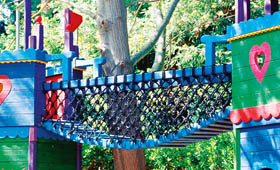
Swinging Bridge
Another popular bridge is the Swinging Bridge (also called the BouncyBridge.) The redwood bridge ties are strung on two heavy-duty cables with a spacer ball between each tie. The effect is dazzling: the bridge shakes and moves as the kids walk across the bridge. The gaps between the ties let the kids experience the sense of height while the hand-woven rope net railing safely holds them in. Often kids use the swinging bridge as a hang-out spot to have conversations, lying on their backs, rocking the bridge with their feet…

Arched Bridge
There is something so beautiful about the shape of the Arched Bridge. It takes more work to make anything in a curved shaped, but isn’t it worth it! The Arched Bridge can span two towers with or without swings underneath and can come with your choice of railing styles as well.
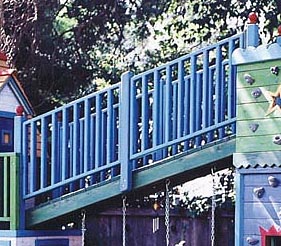
Angled Bridge
An AngledBridge gives kids the feeling of approaching the summit: get to the highest ground! I’ve found there just aren’t enough angled bridges in everyday life, so when you stumble on one in a play structure, it’s a special experience! The Angled Bridge is also agreat way to deal with a change in grade between two towers. The Cape Codder Deluxe is another example: when the family that owned the Cape Codder wanted to add a climbing tower and slide; the angled bridge was an exciting fun way to deal with the 2’ difference in the upper deck heights.
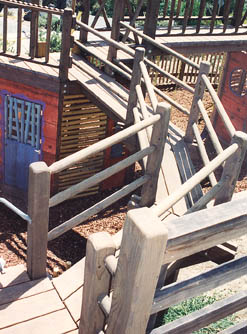
Catwalk
A Catwalk is usually a long narrow bridge marked by several turns. Custom designs for unusual shaped yards often need a Catwalk to transition the kids from one part of the structure to another when a straight line won’t work. So why not turn that disadvantage into a fun play event? The Catwalk feels adventurous – and most kids think the more twists and turns the better.

Double bridges
Double bridges often are a clever design solution, as shown in the photo of the Hacienda. I wanted to link the climbing tower and the tree fort with a bridge but I couldn't place them any closer to each other and still get the slide to fit in, so I had to stretch the bridge. But why not have one bridge with swings underneath and a second bridge with a tire swing underneath? Twice the fun!

Drawbridge-style Ramp with picket railing
Ramps are an extra fun way to transition kids from the ground to an upper level. We make several styles of ramps: The Zig Zag shows a good example of a Drawbridge-style Ramp with picket railing. We put wooden strips on top of the decking every foot to help the kids keep a good grip with their feet.
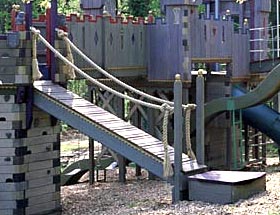
Drawbridge-style Ramp with Giant Rope Railing
We often add a rope on the inside of the railing as well so the kids can pull themselves up. The Connecticut Castle has a Drawbridge-style Ramp with Giant Rope Railing: very medieval looking and lots of fun too.
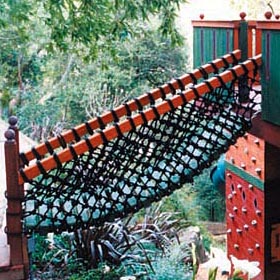
Swinging Ramp
Canyon Perch is a good example of a Swinging Ramp : it’s very similar to the Swinging Bridge except it starts at ground level. They are often steep and not good for very young kids, but the older kids sure like them! The feeling that there is adventure ahead increases with an unusual and slightly difficult entrance like the Swinging Ramp.
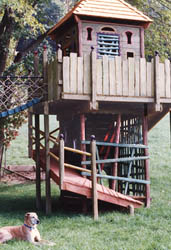
Wrap-Around Ramps
>>Hudson Valley Fort
The wildest ramps I’ve made are the Wrap-Around Ramps. After an inspiring visit to the Guggenheim Museum in NYC, I decided to make a wrap-around ramp as a way up to the 7’ second deck height. As the ramp rises, the head room for the traveler gets narrower and narrower till finally he has to crawl through a 2’ x 2’ opening to ascend the last section. I call this the parent trap: the kids scramble through it no problems, but the parents get stuck unless they are very nimble! The Hudson Valley Fort has the original wrap-around ramp.
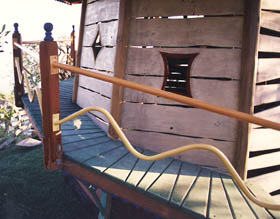
8-sided wrap-around ramp
The Malibu Lighthouse is a nice example of an 8-sided wrap-around ramp with a wavy metal railing.

Earthquake Spring Platform
At the bottom of ramps, I like to add an Earthquake Spring Platform. To a newcomer, it looks like a small entrance deck, but really it’s mounted on 3 car springs. One step and our newcomer thinks we’re having an earthquake! Thenall the other kids pile on and jiggle and giggle away.